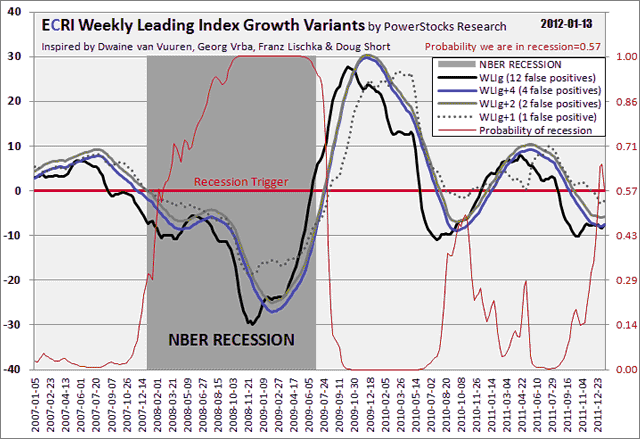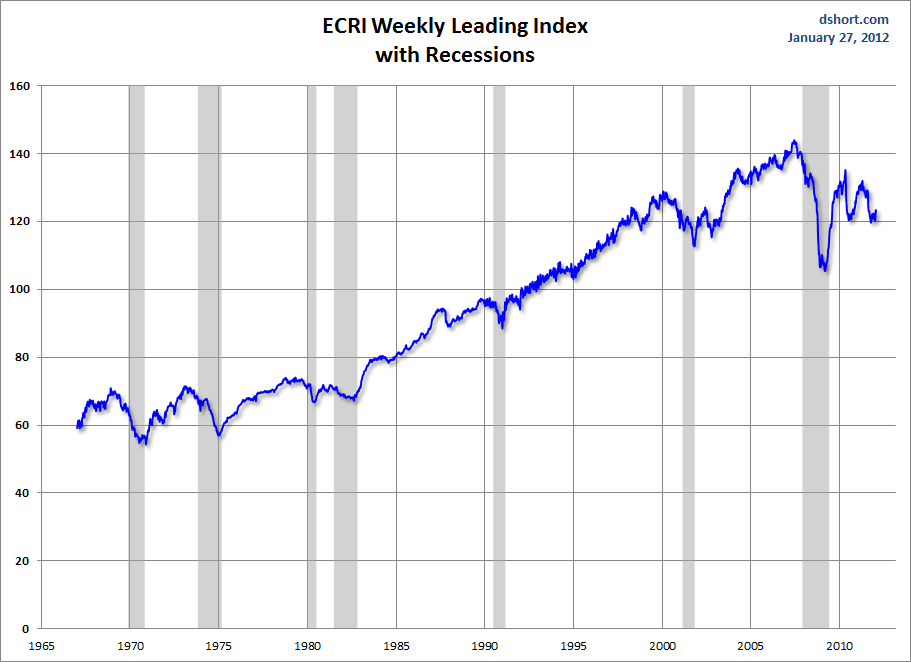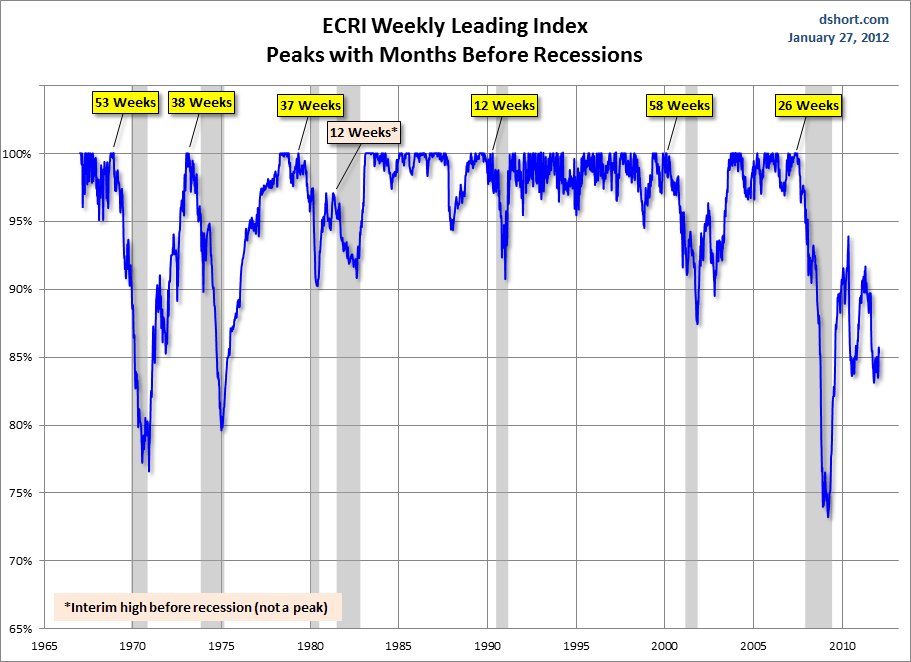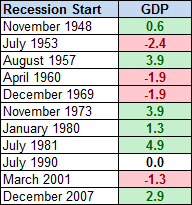The Weekly Leading Index (WLI) growth indicator of the Economic Cycle Research Institute (ECRI) posted -6.5 in its latest reading, data through January 20. The latest public data point is a reduced contraction from last week's -7.6 (a slight downward revision from -7.5). This is the highest level (i.e., least negative) since early September. However, the underlying WLI declined fractionally from an adjusted 123.3 to 122.8 (see the third chart below).
Early last December Lakshman Achuthan, the Co-founder of ECRI, spoke with Tom Keene on Bloomberg Television's Surveillance Midday. You can watch the video on the ECRI website here, with bold heading Recession Update. The eight-minute video is well worth watching in its entirely. I've retained this link in my commentary since my December 9th weekly update because ECRI continues to feature it as the lead on its website, which I take as an affirmation of their recession call.
Achuthan's Bloomberg interview Obviously, ECRI's recession call remains quite controversial in financial circles. The perma-bears are generally supportive of the forecast, while the predominantly bullish mainstream financial view ranges from highly skeptical to dismissive.
For a fascinating analysis of the ECRI WLI, see these fascinating articles by Dwaine van Vuuren, CEO of PowerStocks Investment Research:
* US Recession - An Opposing View (January 3)
* Using the ECRI WLI to Flag Recessions (January 10)
* Further Improving the Use of the ECRI WLI (January 17, with coauthored with Georg Vrba)
Last week Dwaine sent me the chart below, which should be studied in the context of his January 17 article: For another perspective on Dwaine's indicator research, see the latest commentary from John Hussman in Dwelling In Uncertainty (January 16).
For another perspective on Dwaine's indicator research, see the latest commentary from John Hussman in Dwelling In Uncertainty (January 16).
Background
On September 30th, ECRI publicly announced that the U.S. is tipping into a recession, a call the Institute had announced to its private clients on September 21st. Here is an excerpt from the announcement:
Early last week, ECRI notified clients that the U.S. economy is indeed tipping into a new recession. And there's nothing that policy makers can do to head it off.
ECRI's recession call isn't based on just one or two leading indexes, but on dozens of specialized leading indexes, including the U.S. Long Leading Index, which was the first to turn down — before the Arab Spring and Japanese earthquake — to be followed by downturns in the Weekly Leading Index and other shorter-leading indexes. In fact, the most reliable forward-looking indicators are now collectively behaving as they did on the cusp of full-blown recessions, not "soft landings." (Read the report here.)
For a close look at this movement of this index in recent months, here's a snapshot of the data since 2000.
Now let's step back and examine the complete series available to the public, which dates from 1967. ECRI's WLI growth metric has had a respectable record for forecasting recessions and rebounds therefrom. The next chart shows the correlation between the WLI, GDP and recessions. 
A significant decline in the WLI has been a leading indicator for six of the seven recessions since the 1960s. It lagged one recession (1981-1982) by nine weeks. The WLI did turned negative 17 times when no recession followed, but 14 of those declines were only slightly negative (-0.1 to -2.4) and most of them reversed after relatively brief periods.
Three other three negatives were deeper declines. The Crash of 1987 took the Index negative for 34 weeks with a trough of -6.8. The Financial Crisis of 1998, which included the collapse of Long Term Capital Management, took the Index negative for 23 weeks with a trough of -4.5.
The third significant negative came near the bottom of the bear market of 2000-2002, about nine months after the brief recession of 2001. At the time, the WLI seemed to be signaling a double-dip recession, but the economy and market accelerated in tandem in the spring of 2003, and a recession was avoided.
The question had been whether the WLI decline that began in Q4 of 2009 was a leading indicator of a recession. The published index has never dropped to the -11.0 level in July 2010 without the onset of a recession. The deepest decline without a recession onset was in the Crash of 1987, when the index slipped to -6.8. ECRI's managing director correctly predicted that we would avoid a double dip. The nine quarters of positive GDP since the end of the last recession supports ECRI's stance.
The Certainty and Dramatic Language of ECRI's New Recession Call
What is particularly striking about ECRI's current recession call is the fervor and certainty of the language in the public press release:
Here's what ECRI's recession call really says: if you think this is a bad economy, you haven’t seen anything yet. And that has profound implications for both Main Street and Wall Street.
I continue to be astonished at the complete absence of wiggle room in the announcement, nor have there been any public communications from ECRI to qualify or soften its recession call. ECRI has put its credibility on the line. As I've said before, if the U.S. avoids a recession, ECRI's reputation will be permanently damaged.
A Look at the Underlying index
With the Growth Index showing so little change over the past several weeks, let's take a moment to look at the underlying Weekly Leading Index from which the Growth Index is calculated. The first chart below shows the index level.; For a better understanding of the relationship of the WLI level to recessions, the next chart shows the data series in terms of the percent of the previous peak. In other words, a new weekly high registers at 100%, with subsequent declines plotted accordingly.
For a better understanding of the relationship of the WLI level to recessions, the next chart shows the data series in terms of the percent of the previous peak. In other words, a new weekly high registers at 100%, with subsequent declines plotted accordingly. 
As the chart above illustrates, only once has a recession occurred without the index level achieving a new high -- the two recessions, commonly referred to as a "double-dip," in the early 1980s. Our current level is 12.8% off the most recent high, which was set 4.6 years ago. The longest stretch between highs was about 5.2 years from February 1973 to April 1978. But in index level rose steadily from the trough at the end of the 1973-1975 recession to reach its new high in 1978. The pattern we're now witnessing is quite different.
But What About the 2.8 Q4 GDP? 
Earlier today the BEA posted an Advance Estimate of 2.8 for Q4 GDP, a level that was somewhat below the consensus estimates, which ranged from 3.1 to 3.5, but definitely above the conventional view of the economy on the threshold of a recession. ECRI itself did not offer a specific date for the start of the forecast recession. A general view is that ECRI's headlights shine about six months into the future, which would make Q1 2012 GDP the critical number for evaluating ECRI's stance.
The U.S. has had eleven recessions since the earliest quarterly GDP calculations, which began in 1948. In the month declared by the National Bureau of Economic Research (NBER) as the beginning of the recession, quarterly GDP for that month has only been negative four times. In fact, four of the six positive GDP recession starts were at GDP levels higher than the 2.8 of Q4 2011.
ECRI doesn't provide the general public with the analytical details behind its calls, but the Hoisington Investment Management Q4 Report also makes a 2012 recession call accompanied by an extended economic analysis that includes several key topics:
* soaring debt-to-GDP
* contractionary fiscal and monetary policies
* anticipated decline in exports
* a weakened consumer
* capital spending cutbacks
For another take on the controversial topic of recession calls, see also the interesting article by Jeff Miller, Why the Average Investor Is Bamboozled by Recession Forecasts (January 18).
Note: How to Calculate the Growth series from the Weekly Leading Index
ECRI's weekly Excel spreadsheet includes the WLI and the Growth series, but the latter is a series of values without the underlying calculations. After a collaborative effort by Franz Lischka, Georg Vrba, Dwaine van Vuuren and Kishor Bhatia to model the calculation, Georg discovered the actual formula in a 1999 article published by Anirvan Banerji, the Chief Research Officer at ECRI: The three Ps: simple tools for monitoring economic cycles - pronounced, pervasive and persistent economic indicators.
Here is the formula:
"MA1" = 4 week moving average of the WLI
"MA2" = moving average of MA1 over the preceding 52 weeks
"n"= 52/26.5
"m"= 100
WLIg = [m*(MA1/MA2)^n] – m
- English (UK)
- English (India)
- English (Canada)
- English (Australia)
- English (South Africa)
- English (Philippines)
- English (Nigeria)
- Deutsch
- Español (España)
- Español (México)
- Français
- Italiano
- Nederlands
- Português (Portugal)
- Polski
- Português (Brasil)
- Русский
- Türkçe
- العربية
- Ελληνικά
- Svenska
- Suomi
- עברית
- 日本語
- 한국어
- 简体中文
- 繁體中文
- Bahasa Indonesia
- Bahasa Melayu
- ไทย
- Tiếng Việt
- हिंदी
ECRI Recession Call: Growth Index Contraction Eases Further
Published 01/28/2012, 09:45 AM
Updated 07/09/2023, 06:31 AM
ECRI Recession Call: Growth Index Contraction Eases Further
Latest comments
Loading next article…
Install Our App
Risk Disclosure: Trading in financial instruments and/or cryptocurrencies involves high risks including the risk of losing some, or all, of your investment amount, and may not be suitable for all investors. Prices of cryptocurrencies are extremely volatile and may be affected by external factors such as financial, regulatory or political events. Trading on margin increases the financial risks.
Before deciding to trade in financial instrument or cryptocurrencies you should be fully informed of the risks and costs associated with trading the financial markets, carefully consider your investment objectives, level of experience, and risk appetite, and seek professional advice where needed.
Fusion Media would like to remind you that the data contained in this website is not necessarily real-time nor accurate. The data and prices on the website are not necessarily provided by any market or exchange, but may be provided by market makers, and so prices may not be accurate and may differ from the actual price at any given market, meaning prices are indicative and not appropriate for trading purposes. Fusion Media and any provider of the data contained in this website will not accept liability for any loss or damage as a result of your trading, or your reliance on the information contained within this website.
It is prohibited to use, store, reproduce, display, modify, transmit or distribute the data contained in this website without the explicit prior written permission of Fusion Media and/or the data provider. All intellectual property rights are reserved by the providers and/or the exchange providing the data contained in this website.
Fusion Media may be compensated by the advertisers that appear on the website, based on your interaction with the advertisements or advertisers.
Before deciding to trade in financial instrument or cryptocurrencies you should be fully informed of the risks and costs associated with trading the financial markets, carefully consider your investment objectives, level of experience, and risk appetite, and seek professional advice where needed.
Fusion Media would like to remind you that the data contained in this website is not necessarily real-time nor accurate. The data and prices on the website are not necessarily provided by any market or exchange, but may be provided by market makers, and so prices may not be accurate and may differ from the actual price at any given market, meaning prices are indicative and not appropriate for trading purposes. Fusion Media and any provider of the data contained in this website will not accept liability for any loss or damage as a result of your trading, or your reliance on the information contained within this website.
It is prohibited to use, store, reproduce, display, modify, transmit or distribute the data contained in this website without the explicit prior written permission of Fusion Media and/or the data provider. All intellectual property rights are reserved by the providers and/or the exchange providing the data contained in this website.
Fusion Media may be compensated by the advertisers that appear on the website, based on your interaction with the advertisements or advertisers.
© 2007-2024 - Fusion Media Limited. All Rights Reserved.
